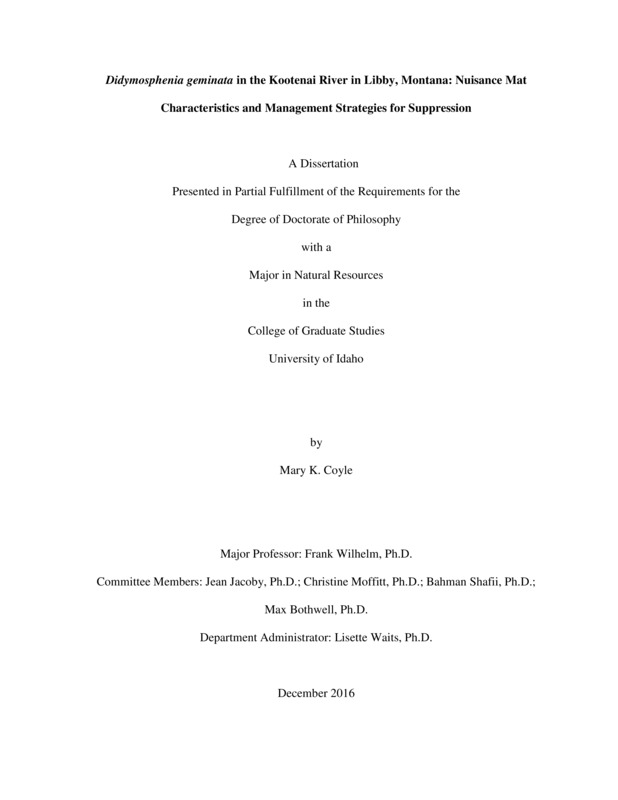Didymosphenia geminata in the Kootenai River in Libby, Montana: Nuisance Mat Characteristics and Management Strategies for Long-term Suppression
Coyle, Mary. (2016). Didymosphenia geminata in the Kootenai River in Libby, Montana: Nuisance Mat Characteristics and Management Strategies for Long-term Suppression. Theses and Dissertations Collection, University of Idaho Library Digital Collections. https://www.lib.uidaho.edu/digital/etd/items/coyle_idaho_0089e_11027.html
- Title:
- Didymosphenia geminata in the Kootenai River in Libby, Montana: Nuisance Mat Characteristics and Management Strategies for Long-term Suppression
- Author:
- Coyle, Mary
- Date:
- 2016
- Embargo Remove Date:
- 2018-01-23
- Keywords:
- Didymo Didymosphenia geminata Kootenai River nuisance mats phosphorus
- Program:
- Natural Resources
- Subject Category:
- Limnology; Water resources management; Natural resource management
- Abstract:
-
A native diatom of the Pacific Northwest (PNW), Didymosphenia geminata has progressed into a nuisance species in rivers and streams across the PNW region including the Kootenai River of Libby, Montana. Forming benthic mats that resemble sewage material, nuisance D. geminata alters macroinvertebrate communities, degrades aesthetic value and affects recreational activities. Mats of D. geminata were first noticed in the Kootenai River in the early 2000s and have since remained a ubiquitous year-round nuisance. To research the ecology of D. geminata and to develop potential management strategies for nuisance mats, a flume-based mesocosm system was built below the Libby Dam near the Kootenai River.
An overview of the geographic patterns of D. geminata throughout northern Idaho and northwestern Montana and the environmental variables attributed to varying degrees of mat presence were analyzed for background to the development of management strategies (Appendix 1 and 2). Based on previous research, phosphorus enrichment as a suppression tool was analyzed in two studies in (2013 and 2014). These studies demonstrated that a small amount of dissolved phosphorus (P) suppressed D. geminata stalk production and the subsequent nuisance mat formation (Chapter 3). An in-river study of a dissolved P treatment further defined the potential of P enrichment as a management strategy for nuisance mats (Chapter 5).
Mechanisms behind nuisance mat formation of this native species were investigated to explain its seemingly random persistence and prevalence. Manipulated ratios of nitrogen to phosphorus were tested and increased nitrogen concentrations were identified to result in increased stalk growth (Chapter 4). Based on these findings, management recommendations for nuisance mats of Didymosphenia geminata are presented in the final chapter.
- Description:
- doctoral, Ph.D., Natural Resources -- University of Idaho - College of Graduate Studies, 2016
- Major Professor:
- Wilhelm, Frank M
- Committee:
- Jacoby, Jean; Bothwell, Max; Shafii, Bahman; Moffitt, Christine
- Defense Date:
- 2016
- Identifier:
- Coyle_idaho_0089E_11027
- Type:
- Text
- Format Original:
- Format:
- application/pdf
- Rights:
- In Copyright - Educational Use Permitted. For more information, please contact University of Idaho Library Special Collections and Archives Department at libspec@uidaho.edu.
- Standardized Rights:
- http://rightsstatements.org/vocab/InC-EDU/1.0/

